

 STUART JORDAN explores the history and evolution of this track system.
STUART JORDAN explores the history and evolution of this track system.
As I found researching my previous article on Atmospheric Railways so interesting, I thought that I would look at some other types of railways beyond the conventional ‘two rails on sleepers’. In this article I’m going to explore the rack railway.
Rack and pinion railways, also known as cog railways, are aptly named. They are used on steep gradients, where wheel-to-rail friction is not enough for the locomotive to operate. This is generally at about 10% incline. Unlike an atmospheric railway the trains are pulled by locomotives running by conventional means (steam, electric, diesel). The track itself has an additional ‘rack rail’ which is toothed. The locomotive has one or more geared wheels which mesh with the rack. This provides the locomotive with the extra traction required to pull the train up the gradient.

Different rack systems: Riggenbach, Strub, Abt and Locher.
Unsurprisingly, most rack railways have been constructed in mountainous areas or in mining operations, but there are some such as the Lyon Metro that have been built in urban environments. Steam locomotives had to be specially modified to work on rack railways. The water in the boiler is required to completely cover the tubes and sheets and this is not possible if the locomotive is at a steep angle.
To get round this, steam locomotives on rack railways were designed with cabs and boilers ‘leaning’ forwards relative to the wheels, making them horizontal when running up the gradient. This factor, which meant that engine shops and other infrastructure would also have to be built askew on the gradient. The alternative is to use a vertical boiler. These issues contributed to why rack railways were early adopters of electric locomotives.
But we’re getting ahead of ourselves. Many engineers have produced their own methods for a rack railway, often improving on the work of others before them. It is no surprise, considering the terrain they traverse, that many of the innovators of rack railways are Swiss. But, before that, there was Yorkshire...
The first rack railway (and the world’s oldest continuously running railway) is the Middleton Railway in Hunslet, near Leeds. It was built in 1812 over the route of an existing horse-drawn wagonway which delivered coal from Middleton to Leeds. The colliery manager, John Blenkinsop, believed that a locomotive that was light enough not to break the tracks would not provide sufficient traction to pull the heavy coal wagons up the gradients on the line. His solution was track rail with rack teeth on the outer side. This would mesh with a cog wheel on the locomotive. Salamanca, named for the Duke of Wellington’s recent victory in Spain, became the world’s first commercial steam locomotive some seventeen years before the Rainhill Trials.
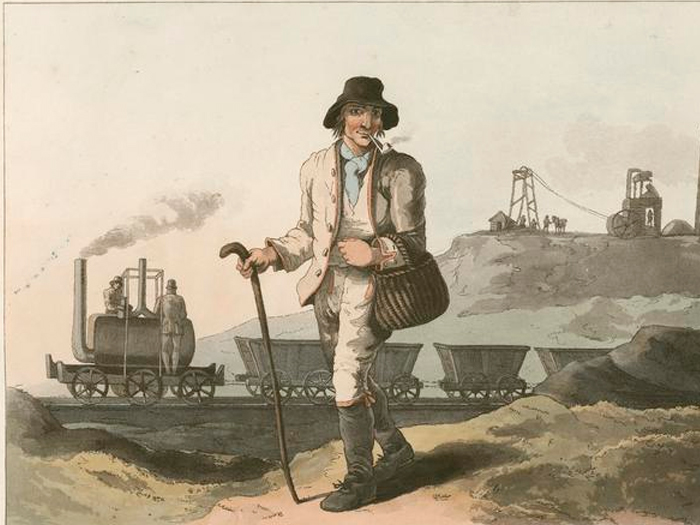
'The Collier', a painting by George Walker, 1814 - with Salamanca in the background.
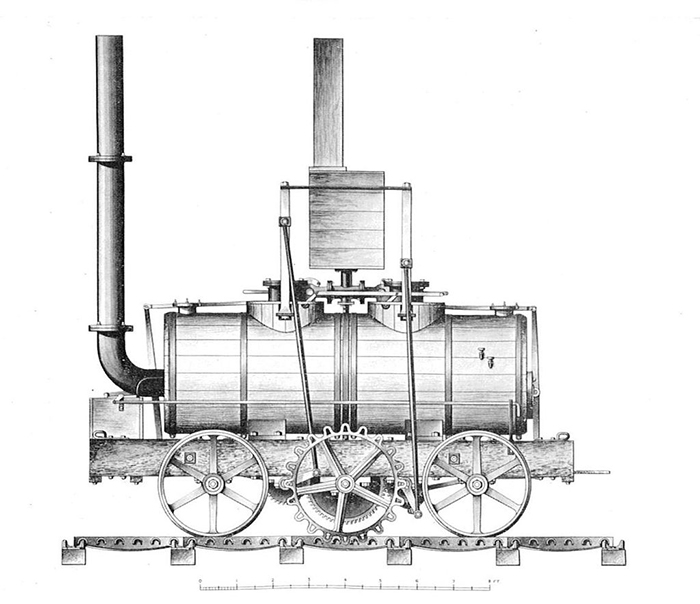
Salamanca again, with Blenkinsop's version with teeth of one side of one of the rails.
The first mountain climbing rack railway was built up Mount Washington in New Hampshire, USA. It was the brainchild of engineer Sylvester Marsh, who was climbing the mountain one day in 1852 and had the idea that a railway to the summit would be a profitable venture. His rack method was different to Blenkinsop’s; rollers would be set as rungs between two L-shaped rails, which would be gripped by a cog in the centre of the axle. The first commercial runs began in 1868, with the track reaching the summit in 1869. The steam locomotives used vertical boilers. The railway still runs, taking tourists and skiers up to the summit, where there is a weather station and an observatory.
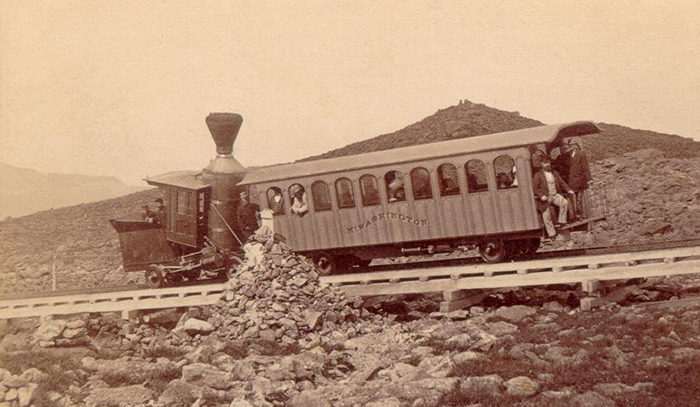
The Mount Washington Cog Railway.
The first mountain cog railway in Europe was inspired by the Mount Washington line. The Swiss Consul to the United States visited Mount Washington and seeing the effect it had on tourism, reported back enthusiastically. The Swiss engineer Niklaus Riggenbach already had a French patent for a rack railway design, so the Swiss government employed him to build a rack railway up Mount Rigi. The line runs from Vitznau on the banks of Lake Lucerne to the summit of the mountain and opened in 1871. Riggenbach’s system used on the Vitznau-Rigi Railway is similar to that of Marsh on the Mount Washington; however, it uses a fixed ladder centre rail rather than rails which is more expensive to produce. Riggenbach started his own company, Maschinenfabrik der Internationalen Gesellschaft für Bergbahnen (IGB), to manufacture rack locomotives.
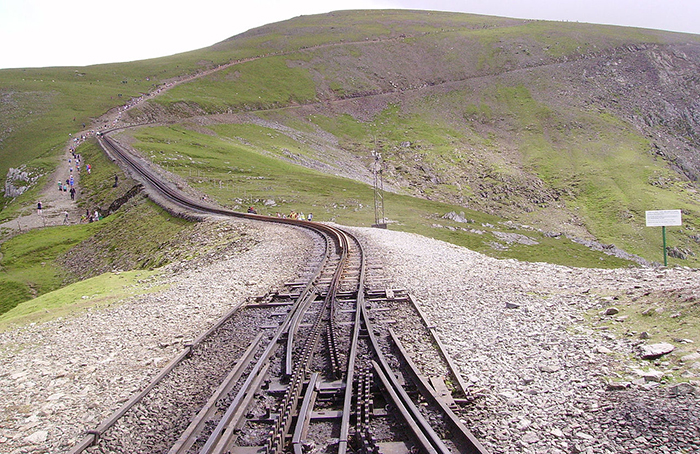
The Abt track system on the Snowdon Mountain Railway.
Carl Roman Abt was also a Swiss engineer, who worked at IGB for Riggenbach. He was keen to overcome the problems and high cost of the Riggenbach system. In 1882 he set up his own company and devised his own rack track system. Rather than a ladder system, the Abt track was a solid bar with offset rack teeth machined into it. This was matched to a pinion with offset teeth, which meant that the gear on the driving wheel was in constant contact with the rack rail. The Abt track suffered greater wear-and-tear than the Riggenbach, but it was cheaper to produce. It was first used on the Harzbahn in Germany in 1885 and was later used in the construction of the Snowdon Mountain Railway in Wales during the 1890s. The Strub system was a simpler version with only one set of teeth on the rail.
Not to be outdone, another Swiss engineer named Eduard Locher looked to make improvements to Abt’s system. The Abt system was not suitable for gradients beyond 1 in 2, as the pinion wheel may jump the gears on the track and cause derailments. Locher explored ways to increase adhesion with his solution being a lot different to other rack methods. His design was a track with gear teeth cut into the sides. Two horizontal pinions mounted on the underside of the locomotive grip the rail and keep the locomotive stable and centred. This meant that the train was not susceptible to toppling in high crosswinds. Utilised on some mine railways, the Pilatus Railway in Switzerland which opened in 1889 is the only passenger railway the Locher system is used on.
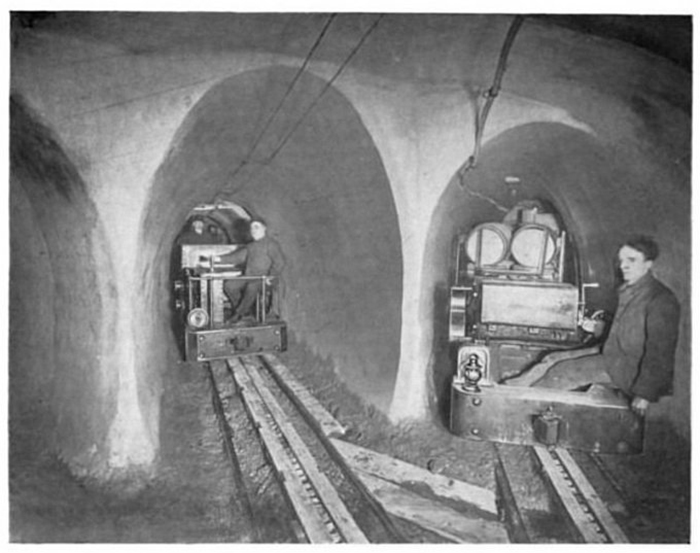
Morgan Electric locomotives on the railway under Chicago.
As previously mentioned, rack railways were early adopters of electric traction. Some lines, like the Pilatus, powered their electric trains with overhead wires. The American engineer EC Morgan developed a rack railway system in 1900 that used the rack rail as a third rail for electric running. The rack and pinion used are similar to the Riggenbach system; a central rail with regular square holes punched into it. A non-electrified version was also produced. The Goodman Equipment Co. marketed it for use in the mining industry, where it was very popular for overcoming steep gradients underground. Many American mines used the system and Goodman had a sales office in Cardiff, Wales, to try and capitalise on the British market. The Goodman system was used on part of The Chicago Tunnel network, a freight system built in the early 20th Century beneath the city of Chicago, Illinois. Most of the spoil from the construction of the tunnels was hauled up a 12% grade Morgan rack system to Grant Park disposal station.
There are many, many rack railways that have not been mentioned here but we have covered the main innovations and types that have been developed. A lot of these railways are still running and can be visited.